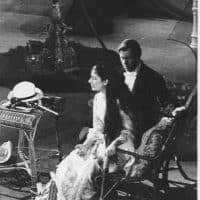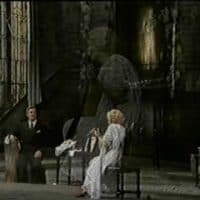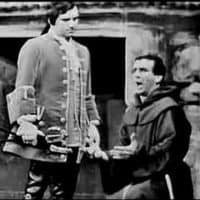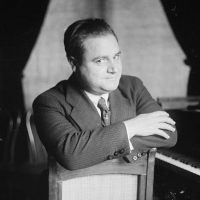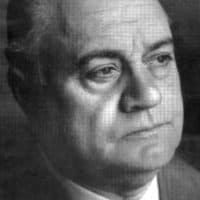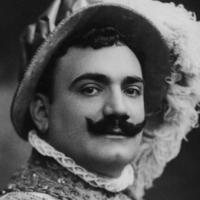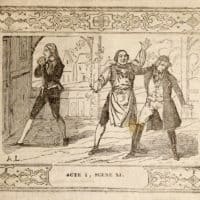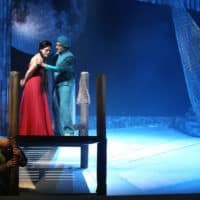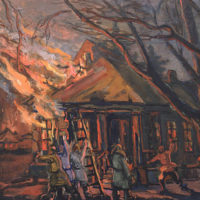What crosses one’s mind if confronted with the terms “Italian song” and “Italian art song”? Well, titles like O sole mio and Torna a Surriento are for sure common connotations, as well as Mamma or Incantesimo. Sure, the first two are Neapolitan songs, and the latter are pop songs. Further brooding will put forth songs like Malinconia by Bellini and Rossini’s La Danza. And then? Does the Italian culture of song consist of Neapolitan and pop songs?
How different are the connotations when one thinks of the two other great European opera and singing nations! Names like Schubert, Schumann, Brahms, Wolf and Mahler pop up for the German repertoire, celebrities like Richard Strauss, Goethe and Heine. The same applies for the French repertoire: Gounod, Debussy, Ravel, Fauré, Duparc and the poems by Villaine and Baudelaire. Russian composers like Mussorgsky and Rachmaninoff are famous creators of art songs, and even Northern Europe, which is, except for its famous singers, an operatic no man’s land, possessed song composers of international fame: Grieg and Sibelius. And what about Italy?
One of the biggest problems regarding Italian art songs is the fact that they have widely been ignored by singers and record companies. Small, exotic record companies like Bongiovanni have in the course of the past ten years begun to fill the gap – being of course confronted with the lack of capable tenors. Light music like Neapolitan songs and pop songs have on the other side always been widely recorded by famous singers like Gigli, Bechi, di Stefano and Del Monaco. Neapolitan songs are of course not considered to be pop music, but the simpleness of composition, the dialect, and the fact that the Neapolitan song is at least as often performed by pop singers as it is by opera singers, shows that the Neapolitan song does not belong to the category “art song.” The problem of the “real” art song is not that there are no songs – the problem is that they are seldomly sung and recorded. Just as Hilaire Belloc said: “It is the best of trades to make songs, and the second best to sing them.” And the Italian music history is full of unsung songs – as the following examples will illustrate.
Gioacchino Rossini‘s fame is first of all based on his opera production, and La Danza is the only of his songs that is well known to most opera lovers. This is strange, especially when one remembers that Rossini (1792-1868) used to organize very popular musical happenings in Paris’ drawing rooms, presenting his newest songs to the charmed bourgeoisie and the enthusing music press. The songs of these beloved evenings were later combined in the collections Soirées Musicales and Les péchés de vieillesse. La Danza is a part of the Soirées Musicales, but it’s by far not the only song of this collection which is interesting for the tenor voice. The numbers 1 (La Promessa), 3 (La Partenza) and 4 (L’Orgia) of the Soirées are both charming and, just like La Danza, challenging compositions. The lyrics of La Promessa (by Pietro Metastasio) is simple: A lyrical I promises eternal love – Don’t believe that I will ever stop loving you, no, I would never fool you, not even for the fun of it. But the music demands a great deal of the tenor: seven high A flats, many Gs and Fs, the song requires verve and suppleness. This song has been recorded by Bergonzi and Pavarotti, and, if I remember right, by the Japanese tenor Taro Ichihara. La Partenza is a song which requires great coloratura skills. It contains an endless number of Fsharps and Gs and culminates in a high A. L’Orgia (to words by Carlo Pepoli), is the most difficult of these songs. It’s a very vivid song about a bacchanal, praising women and alcohol, Bacco ed Amor! The tessitura is very high and demanding: Two high Bflats, and again an endless number of high Gs and Fs – a singer who does not possess a solid voix mixte or at least a falsetto rinforzato will be lost (if he does not have an extraordinary stamina!).
The songs of Vincenzo Bellini (1801-1835) will be known to those who are singers or who study singing. They are or should at least be required reading for each student, they are well written and a good school for the passaggio. But they are above all music of unusual quality, just like Bellini’s operas – and it’s a strange matter of fact that they are seldomly performed. Especially the cycle Sei Ariette would have deserved more attention – not only by students. It contains the songs Malinconia, Vanne o rosa, Bella Nice, Almen se non poss’io, Per pietà and Ma rendi pur contento. Two other songs deserve to be mentioned: Dolente immagine di Fille mia and Vaga luna. Some of these songs have been recorded by Bergonzi, Carreras and Pavarotti, who actually used to sing all of the Ariette in several concerts in the 1980s and 1990s.
Giuseppe Verdi (1813-1901) wrote a large number of songs which never really became famous. The only tenor who recorded a large number of them was Donaldo Pilli (obviously a nom de plum – the recital, a whole LP, was found on the Saga label). The mediocre quality of the tenor did unfortunately not evoke a permanent impression. Alfredo Kraus has recorded a couple of songs, as well as José Carreras and the new tenors Otto Linsi, Ruben Amoretti and Sergej Larin (whose chesty singing left a rather bad impression).
Giacomo Puccini‘s (1858-1924) songs are as unknown as Verdi’s, maybe due to the fact that most of them contain the same melodies he had used in his operas. Listening to his songs (or rather singing them – which tenor has recorded a larger number of them?) one will at once recognize the famous melodies from La Bohème, Manon Lescaut, Le Villi and so on. It might very well be that the odour of self-plagiarism has prevented a success the songs certainly would have deserved – were it not for his operas who were there first!
Other opera composers, such as Pietro Mascagni (1863-1945), Ruggero Leoncavallo (1859-1919) and Riccardo Zandonai (1883-1944) were just as unfortunate. Especially Mascagni and Zandonai wrote a big number of songs which are rarely performed. The only songs by Mascagni which are more or less famous are the Serenata, featured in this AM, Alla luna and Risveglio. In 1999 the tenor Angel Rodriguez has recorded a couple of rare Mascagni songs [Bongiovanni GB 2235]. A larger number of Mascagni songs has been recorded by tenor Fausto Tenzi in 2001, but the uninteresting timbre of his voice does unfortunately not do justice to the music [Art Music 47636]. Zandonai’s songs have, at least not as far as I know, been recorded by any tenor – which is a pity. Especially the cycles Sei melodie (including Visione invernale), written in 1905 and Tre ariette from 1912 (including Notti di agosto) are very charming, atmospheric pieces of music. Bongiovanni has recently published a CD entitled Italian songs by opera composers [GB 2369-2] that contains, in addition to songs by Leoncavallo (Aprile, Mattinata), Puccini (Avanti Urania, A te, Mentia l’avviso, Terra e mare, Morire) and Zandonai (Ultima rosa – La serenata – Sotto il ciel – I due tarli), songs by Umberto Giordano, Francesco Cilea and Franco Alfano. The six Giordano songs (Sei liriche) are published for the first time. The Cilea piece (Non ti voglio amar) and especially the songs by Alfano were a good choice (Venne e mi sedette accanto, La notte e l’anima, Mamma il giovane principe) – if it had not been for Antonio de Palma, the tenor of these recordings. He only impresses with brutal singing, and the originally beautiful dark timbre is clouded by an unhealthy, sandy sounding and badly focused sound production. Ida Fratta, the soprano on his side, sounds much more pleasant, but the decent impression she makes is almost completely nullified by the amateurish recording technique.
Francesco Paolo Tosti (1846-1916) is, as to songs, the most famous of the hitherto named composers. His works (ca. 360 songs) can be divided into two parts: the serious and the light work. Many of Tosti’s songs are simple, romantically overloaded pop songs, sobstuff and Kitsch, while other compositions reflect great compositional skills, a freshness and a clearness that reminds to Liszt’s best piano works (like the Années de Pélèrinage) – far from any soppy effect. Tenor Ben Heppner has recently recorded a CD dedicated to better Tosti songs, and the selection is indeed tasteful [Deutsche Grammophon]. Among his most famous songs we can find L’ultima canzone, often sung and recorded by tenors like Martinelli, Di Stefano, Schipa, Gigli, Caruso, of course Pavarotti – but also by singers like Conchita Supervia and Piero Cappuccilli. Another famous song is Ideale, a very charming little piece, light and lost in reverie. But songs like Invano, Tormento and Tristezza (the latter nicely recorded by Augusto Dianni) are first class Kitsch, first class, but Kitsch.
Among Tosti’s best works rank the cycles Malinconia and Quattro canzoni di Amaranta – serious songs based on poems by Gabriele d’Annunzio. One of the Quattro canzoni is the famous L’alba separa dalla luce l’ombra, featured in this focus feature.
Ottorino Respighi (1879-1936) is first of all known for his orchestral works (Pini, Fontane and Feste di Roma), while his songs are relatively unknown. Personally I would say that Respighi was the most talented Italian songwriter of the last century (included the composers named above). The only problem regarding his songs is that most of them are not written for the tenor voice but for the mezzo soprano and the baritone. Transpositions exist of course for most of the songs – but they are still rarely performed and recorded. A recording of many Respighi songs has been made in 1998, with tenor Leonardo de Lisi, the soprano Andrea Catzel and others. But again, the tenor leaves all too much to be desired, and the sound quality of the recordings is, just as in the case of the named Bongiovanni release, disastrous [Channel Classics].
Respighi’s most famous song is undoubtedly Nebbie (to words by Ada Negri), recorded by Gobbi, Olivero, Scotto – but also by Fleta, Kraus and Pavarotti. But there’s more than just that famous cry of a lonely freezing woman in the fog: songs like Nevicata, Pioggia, Mattinata, O falce di Luna and many others of rare beauty, and it’s a shame that none of the great tenors of the last century has paid more attention to Respighi’s unique songs. One of the most beautiful is presented in this AM: Sopra un’aria antica to the text of d’Annunzio.
Other modern composers have been treated even worse: the talk is about Ildebrando Pizzetti (1880-1968), Gian Francesco Malipiero (1882-1979), Alfredo Casella (1883-1947) – other members of the so called generazione dell’80 – and Luigi Dallapiccolla (1904-1975), for just naming the most prominent examples. Pizzetti might be a well known name to many of us because of his operas (of which L’assassino nella cattedrale is the most famous) and his Requiem. But his songs, especially the wonderful cycle Cinque Liriche to words by d’Annunzio, Pàntini, Tommasèo and Papini, including I Pastori (which is a real pearl), and Erotica deserve more attention. Also Malipiero has written songs of high quality, especially the Sonetti della fate (again to poems by d’Annunzio) and the Stagioni Italiche are more than just worth mentioning. Also Dallapiccola’s Laudi deserve to be revealed. None of these songs has, at least not as far as I know, been recorded by any tenor.
That modern music – like Dallapiccola’s and Casella’s – is “unhealthy” for the voice and incompatible with the classical bel canto technique is a common and, at least as to Italian composers, wrong prejudice. Many of the composers named above had great understanding for the human voice and wrote excellent, very beautiful and interesting exercises, collected by the publisher Ricordi in the two volumes Vocalizzi nello stile moderno. These two highly recommended volumes contain vocalizzi by Alfano, Cilea, Giordano, Marinuzzi, Pedrollo, Pick-Mangiagalli, Respighi, Tommasini, Casella, Castelnuovo-Tedesco, Malipiero, Mulè, Pizzetti, Pozzoli, Vittadini and Zandonai. Many of them are of superb quality (musically seen) and can be performed in concerts [Edizioni Ricordi 1046 and 1049].
The last composer I would like to talk about in this context is Pietro Cimara (1887-1967), a student of Respighi. Cimara lived most of his life in the US, working as a pianist and as conductor – he worked among other places at the Met, and complete performances of Madama Butterfly (a 1940 performance with Albanese and Melton) and a Lucia di Lammermoor from 1949 are preserved on record. But Cimara has also written a large number of rather unknown songs – atmospheric songs, music in the grey zone between tradition and avant-garde, comparable to the colors in Puccini’s Turandot. A series of five songs (Cinque liriche) is dedicated to Mattia Battistini and contains among others the beautiful songs Adorazione, Nostalgia (to words by Heine), Stelle chiare and Mattinata. Two other songs, Visione marina and Stornellata marinara, are songs of superb quality, and very well suited for the concert.
Cimara has been ignored by tenors, but there exist recordings by Giuseppe de Luca (Stornello), Leonard Warren (Canto di primavera), Renata Tebaldi (Stornello) and… Lotte Lehmann! In 1998 the soprano Yolanda Marcoulescou-Stern recorded some songs by Cimara, Respighi and Malipiero [Gasparo Gallante 1005].
Too much great music has been forgotten and waits impatiently to be revealed.
FEATURED SONGS
Tenor Giovanni Malipiero (1906-1970)
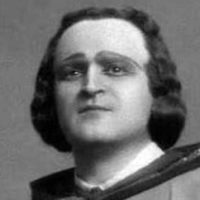 Giovanni Malipiero is one of those singers who can not easily be identified with a specific fach. During his career he sang Rossini roles as well as Cavaradossi in Puccini’s Tosca, he could blossom in dramatic, chesty spinto singing, launching high notes that were second to none (listen for example to act III from the 1946 Manon Lescaut at La Scala with Toscanini). At the same time he could show his strengths in soft and tender, pure lyrical moments – just listen to his recording of Thomas’ Addio Mignon, his Una furtiva lagrima or simply the here presented Toselli serenade.
Giovanni Malipiero is one of those singers who can not easily be identified with a specific fach. During his career he sang Rossini roles as well as Cavaradossi in Puccini’s Tosca, he could blossom in dramatic, chesty spinto singing, launching high notes that were second to none (listen for example to act III from the 1946 Manon Lescaut at La Scala with Toscanini). At the same time he could show his strengths in soft and tender, pure lyrical moments – just listen to his recording of Thomas’ Addio Mignon, his Una furtiva lagrima or simply the here presented Toselli serenade.
Malipiero started his career in the end 1920s, but it was not before 1935 that he was invited to a major opera house (Rome), where he debuted in the role of Lindoro in Rossini’s L’Italiana in Algeri. Malipiero showed great engagement in the music of contemporary composers and rarely performed works: He sang in Massenet’s Jongleur de Nôtre Dame, in Milhaud’s Le pauvre matelot, in Zandonai’s Romeo e Giulietta and Francesca da Rimini, he was part of the first performance of Frazzi’s Don Chisciotte and Lualdi’s La Luna di Cairibi. Malipiero’s voice was very beautiful and agile, with that characteristic relaxed, “broad” sound, which is typical for many Italian singers of that period.
Composer Enrico Toselli (1883-1926)
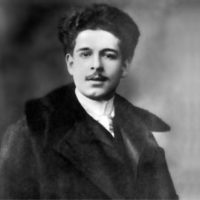 Toselli began studying the piano at the age of 10 and his teachers were Italy’s finest pianists of that time: Giuseppe Martucci and Giovanni Sgambati (a Liszt pupil). Between 1897 and 1907 Toselli was one of the most requested pianists on the globe. To his circle of friends belonged such prominent artists as Massenet, Leoncavallo and d’Annunzio. Soon Toselli was dubbed Il Paderewski Italiano, the “Italian Paderewski”. Toselli has written a number of romances which recently have been published on CD, sung by Fabio Armiliato and Daniela Dessì [Enrico Toselli – Le romanze ritrovate; RS 051-0105].
Toselli began studying the piano at the age of 10 and his teachers were Italy’s finest pianists of that time: Giuseppe Martucci and Giovanni Sgambati (a Liszt pupil). Between 1897 and 1907 Toselli was one of the most requested pianists on the globe. To his circle of friends belonged such prominent artists as Massenet, Leoncavallo and d’Annunzio. Soon Toselli was dubbed Il Paderewski Italiano, the “Italian Paderewski”. Toselli has written a number of romances which recently have been published on CD, sung by Fabio Armiliato and Daniela Dessì [Enrico Toselli – Le romanze ritrovate; RS 051-0105].
The song presented here is one of the most famous pieces by Toselli. Toselli composed it at the age of only 17. Here comes the text (by Alfredo Silvestri) of this charming piece, with English translation by Margaret Smythe.
Enrico Toselli: Come un sogno d’or (Serenata) – Tenor: Giovanni Malipiero (r. 1935)
Come un sogno d’or
Like a golden dream
scolpito è nel core.
it is carved in my heart.
Il ricordo ancor’ di quell’amor
The memory still of that love
che non esiste più.
that no longer exists.
Fu la sua vision
It was the first view
qual dolce sorriso
of that sweet smile
che più lieta fa,
that made us happy,
col suo brillar, la nostra gioventù.
with its brilliance, our youth.
Ma fu molto breve in me
But it was very brief in me
la dolcezza di quel ben svani
the sweetness of which truly vanished
quel bel sogno d’or
this beautiful golden dream
lasciando in me il dolor.
leaving sorrow within me.
Cupo è l’avvenir sempre più tristi
Dark is the future always more sad
i di la gioventù passata
the days of youth passed
sarà rimpianto
will be regretted
mi resta sol,
I remain alone,
sì rimpianto amaro e duol’ nel cor!
such bitter regret and grief in my heart!
Oh raggio di sole,
O ray of sun
Sul mio cammino ahimè non brilli più.
On my path alas no longer shines.
Mai più, mai più.
No longer, no longer
Tenor Jussi Björling (1911-1960)
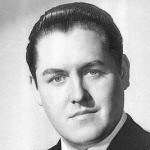 Classical and modern Italian songs were never an important part of Jussi Björling’s repertoire. He has recorded among others di Capua’s O sole mio, Toselli’s serenade and de Curtis’ Torna a Surriento and Carmela (only O sole mio in Italian, the rest in Swedish). There exist furthermore recordings of Denza’s Funiculì funiculà and Rossini’s La Danza (live 1940). Italian songs he performed more often were the Tosti classics Ideale and L’alba separa dalla luce l’ombra (a total of 17 recordings). Of Leoncavallo’s Mattinata exist a total of seven recordings, the first dates from 1929 and the last from 1951. Björling did not sing much contemporary music. The only case are a couple of Sibelius songs, the first performance of Ture Rangstöm’s Ballader (En ballad om Lameks söner, En ballad om narren och döden, En ballad om god sömn) in 1942, with the compser present, and the performances of Tristan’s död by the same composer in 1949 and 1957. This is a real pity – Björlings voice was superbly suited for this kind of music. Sibelius must have thought so as well: there exists a photography by Sibelius with a dedication by the composer – To Jussi Björling, the great singer, the genius!
Classical and modern Italian songs were never an important part of Jussi Björling’s repertoire. He has recorded among others di Capua’s O sole mio, Toselli’s serenade and de Curtis’ Torna a Surriento and Carmela (only O sole mio in Italian, the rest in Swedish). There exist furthermore recordings of Denza’s Funiculì funiculà and Rossini’s La Danza (live 1940). Italian songs he performed more often were the Tosti classics Ideale and L’alba separa dalla luce l’ombra (a total of 17 recordings). Of Leoncavallo’s Mattinata exist a total of seven recordings, the first dates from 1929 and the last from 1951. Björling did not sing much contemporary music. The only case are a couple of Sibelius songs, the first performance of Ture Rangstöm’s Ballader (En ballad om Lameks söner, En ballad om narren och döden, En ballad om god sömn) in 1942, with the compser present, and the performances of Tristan’s död by the same composer in 1949 and 1957. This is a real pity – Björlings voice was superbly suited for this kind of music. Sibelius must have thought so as well: there exists a photography by Sibelius with a dedication by the composer – To Jussi Björling, the great singer, the genius!
The present recording of Leoncavallo’s Mattinata was made in March 1944 during a studio session with Nils Grevillius in Stockholm. It has often been said that Björling was lacking Italianità, but this recording disproves the sceptics. It has more Italianità, more verve, more freshness and more nobility, simply more sun and spring than any other recording I know. This is not only my favourite recording of Mattinata – it’s also generally one of my favourite Björling recordings.
Composer Ruggero Leoncavallo (1857-1919)
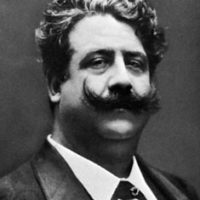 Mattinata has always been a show piece for the tenor voice, and many tenors have sung and recorded the piece. The other songs by Leoncavallo (for example Aprile, L’addio, Pensiero, Ninna Nanna, Hymne à la Lyre, Lasciarti amar, Sérénade fran¸aise, Sérénade napolitaine, La chanson des yeux, Déclaration) are almost completely unknown and have, at least as far as I could find out, not been recorded by famous tenors – except for two recordings by Caruso, Lasciarti amar, recorded in 1913, and Sérénade fran¸aise, recorded in 1915. But the two songs recorded by Caruso are not of the same quality as the evergreen Mattinata. I decided therefore to present my favourite recording of Mattinata: sung by Jussi Björling in a 1944 studio recording. Here comes the text (by Leoncavallo, dedicated to Caruso) with English translation by Antonio Giuliano.
Mattinata has always been a show piece for the tenor voice, and many tenors have sung and recorded the piece. The other songs by Leoncavallo (for example Aprile, L’addio, Pensiero, Ninna Nanna, Hymne à la Lyre, Lasciarti amar, Sérénade fran¸aise, Sérénade napolitaine, La chanson des yeux, Déclaration) are almost completely unknown and have, at least as far as I could find out, not been recorded by famous tenors – except for two recordings by Caruso, Lasciarti amar, recorded in 1913, and Sérénade fran¸aise, recorded in 1915. But the two songs recorded by Caruso are not of the same quality as the evergreen Mattinata. I decided therefore to present my favourite recording of Mattinata: sung by Jussi Björling in a 1944 studio recording. Here comes the text (by Leoncavallo, dedicated to Caruso) with English translation by Antonio Giuliano.
Ruggero Leoncavallo: Mattinata – Tenor: Jussi Björling (r. 1944)
L’Aurora, di bianco vestita,
The dawn, dressed in white,
Già l’uscio dischiude al gran sol,
has already opened the door to the sun,
Di già con le rose sue dita
and with pink fingers
Carezza de’ fiori lo stuol!
caresses the myriads with flowers.
Commosso da un fremito arcano
A mysterious trembling seems
Intorno il creato già par,
to disturb all nature,
E tu non ti desti, ed invano
yet you will not get up, and vainly
Mi sto qui dolente a cantar:
I stand here sadly and sing
Metti anche tu la veste bianca
Dress yourself, too, in white
e schiudi l’uscio al tuo cantor!
and open the door to your serenader!
Ove non sei la luce manca,
Where you are not, all is dark,
Ove tu sei nasce l’amor! etc.
where you are, love is born! etc.
Tenor Francesco Albanese (1912-2005)
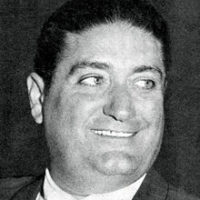 Francesco Albanese belongs undoubtedly to the greatest tenors of the 20thcentury, and it’s hard to believe that his death in June 2005 did not arouse the attention it certainly deserved. Albanese started his studies in the US with Geraldine Farrar, and continued, after his return to Italy, with Francesco Salfi. His debut came in December 1940: In a performance of Gluck’s Alceste he sang the role of Evandro, together with Gina Cigna, Koloman von Pataky, Giuseppe Taddei, Paolo Silveri and Tullio Serafin conducting. Although hitherto first of all a tenor for bit parts he started recording a series of songs in 1941 – while he sang the role of the fisherman in Rossini’s Guglielmo Tell to Bechi’s Tell and Todor Mazaroff’s Arnoldo, the role of the singer in Zandonai’s Giulietta e Romeo to Magda Olivero’s Giulietta and Alessandro Ziliani’s Romeo and the role of Trin in Puccini’s Fanciulla to Giuseppe Lugo’s Johnson. Thenceforward Albanese created main roles – of which Rodolfo, Faust, Alfredo, Almaviva and Fenton were his most requested ones. But Albanese showed, just as Malipiero, also great engagement for contemporary music. He sang in Giordano’s Siberia (1941), Persico’s Locandiera (1942 and 1951), Alfano’s Risurrezione (1948) and Il dottor Antonio (1950), Montemezzi’s Amore dei tre re (1948 and 1951) and L’Incantesimo (1953), Sanzogno’s Regina Uliva (1949), Lualdi’s La luna dei Cairibi (1953) and so on. He also performed songs by contemporary composers: Zandonai’s Il sogno di Rosetta in 1942, and the first performance of Schieppati’s Il cammino sacro in the same year.
Francesco Albanese belongs undoubtedly to the greatest tenors of the 20thcentury, and it’s hard to believe that his death in June 2005 did not arouse the attention it certainly deserved. Albanese started his studies in the US with Geraldine Farrar, and continued, after his return to Italy, with Francesco Salfi. His debut came in December 1940: In a performance of Gluck’s Alceste he sang the role of Evandro, together with Gina Cigna, Koloman von Pataky, Giuseppe Taddei, Paolo Silveri and Tullio Serafin conducting. Although hitherto first of all a tenor for bit parts he started recording a series of songs in 1941 – while he sang the role of the fisherman in Rossini’s Guglielmo Tell to Bechi’s Tell and Todor Mazaroff’s Arnoldo, the role of the singer in Zandonai’s Giulietta e Romeo to Magda Olivero’s Giulietta and Alessandro Ziliani’s Romeo and the role of Trin in Puccini’s Fanciulla to Giuseppe Lugo’s Johnson. Thenceforward Albanese created main roles – of which Rodolfo, Faust, Alfredo, Almaviva and Fenton were his most requested ones. But Albanese showed, just as Malipiero, also great engagement for contemporary music. He sang in Giordano’s Siberia (1941), Persico’s Locandiera (1942 and 1951), Alfano’s Risurrezione (1948) and Il dottor Antonio (1950), Montemezzi’s Amore dei tre re (1948 and 1951) and L’Incantesimo (1953), Sanzogno’s Regina Uliva (1949), Lualdi’s La luna dei Cairibi (1953) and so on. He also performed songs by contemporary composers: Zandonai’s Il sogno di Rosetta in 1942, and the first performance of Schieppati’s Il cammino sacro in the same year.
The present recording dates from 1946. We hear Albanese’s unusual soft and flexible but yet powerful organ, which allows him to sing the difficult serenade without strain. The softness and small focus in the high notes can be regarded as exemplary. Albanese also has a certain melancholy in his voice that can remind to Jussi Björling.
Composer Pietro Mascagni (1888-1945)
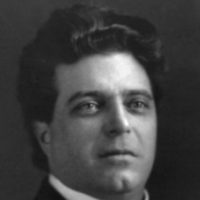 The serenade is one of Mascagni’s best songs and has been sung by many a famous tenor: Martinelli, Di Stefano, Bergonzi and Pavarotti have sung it as well as baritone Tito Gobbi or soprano Renata Tebaldi. Every tenor who wants to sing the song in the original key will be confronted with great difficulties: The tessitura is very high and the song has to be performed tenderly, relaxed, softly and dreamfully, but not without drama. The tessitura is so high that it is difficult to relax. That’s why Bergonzi for example lowered it for a whole note (from g-minor to f-minor). Martinelli sang the song in the original key – the high notes don’t seem to have caused any problems, but the tenderness did all the more! Di Stefano recorded the piece in 1944, when neither his voice nor his musicality were mature. Pavarotti sang the song during a concert at the Met, which was very courageous in my opinion. But there was nervosity in all his looks – and in the voice. He rushed through the song (in the original key) and was obviously relieved when it was over. The performance presented in this feature is one of the best, despite the poor sound quality.
The serenade is one of Mascagni’s best songs and has been sung by many a famous tenor: Martinelli, Di Stefano, Bergonzi and Pavarotti have sung it as well as baritone Tito Gobbi or soprano Renata Tebaldi. Every tenor who wants to sing the song in the original key will be confronted with great difficulties: The tessitura is very high and the song has to be performed tenderly, relaxed, softly and dreamfully, but not without drama. The tessitura is so high that it is difficult to relax. That’s why Bergonzi for example lowered it for a whole note (from g-minor to f-minor). Martinelli sang the song in the original key – the high notes don’t seem to have caused any problems, but the tenderness did all the more! Di Stefano recorded the piece in 1944, when neither his voice nor his musicality were mature. Pavarotti sang the song during a concert at the Met, which was very courageous in my opinion. But there was nervosity in all his looks – and in the voice. He rushed through the song (in the original key) and was obviously relieved when it was over. The performance presented in this feature is one of the best, despite the poor sound quality.
The song was written in 1894 to the text of Lorenzo Stecchetti. The title page wears the dedication A Sua Altezza Maria Duchessa di Mecklenburg Schwerin nata Principessa di Windisch-Graetz.
Pietro Mascagni: Serenata (Come col capo) – Tenor: Francesco Albanese (r. 1946)
Come col capo sotto l’ala bianca
Just like amorous sleeping doves –
dormon le palombelle innamorate,
with the head under the white wing –
così tu adagi la persona stanca
you rest your tired body
sotto le coltri molle e ricamate…
under the soft, embroidered blankets.
La testa bionda sul guancial riposa,
The blond head rests on the pillow,
lieta de’sogni suoi color di rosa…
happy from its rose coloured dreams…
E tra le larve care al tuo sorriso,
And among all those visions that make you smile
una ne passa che ti sfiora il viso.
one comes along and touches your face.
Passa e ti dice che bruciar le vene,
It comes along and tells you that it’s you
che sanguinare il cor per te mi sento…
who makes my veins burn and my heart bleed…
Passa e ti dice che ti voglio bene,
It comes along and tells you that I love you,
che sei la mia dolcezza e il mio tormento.
that you are my sweetness and my torture.
Bianca tra un nimbo di capelli biondi,
Happily you smile at your bright dreams,
lieta sorridi ai sogni tuoi giocondi.
white, under the nimbus of your blond hair.
Ah non destarti, o fior del paradiso,
Ah, don’t wake up, o flower from paradise,
ch’io vengo in sogno
so I can enter your dream
per baciarti in viso!…
and kiss your face!
Tenor Ferruccio Tagliavini (1913-1995)
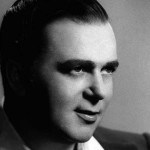 “One October day whilst at ‘I Pini’ [Rome] I received a telephone call from Florence. It was Mario Labroca who wanted me to hear a young tenor to whom he was thinking of giving a part in ‘Astuzie femminili’ by Cimarosa in the edition revised by Respighi, which was to be staged at the ‘Teatro alla Pergola’ in May 1939. (…) Naturally I went to Florence; the young singer in question was Ferruccio Tagliavini; he was then still a novice, but I was immediatley spellbound by the beauty of his voice which, without having the same volume, was like Gigli’s in quality, emission and phrasing. ‘He suits me fine’, I said immediately.” Elsa Respighi*
“One October day whilst at ‘I Pini’ [Rome] I received a telephone call from Florence. It was Mario Labroca who wanted me to hear a young tenor to whom he was thinking of giving a part in ‘Astuzie femminili’ by Cimarosa in the edition revised by Respighi, which was to be staged at the ‘Teatro alla Pergola’ in May 1939. (…) Naturally I went to Florence; the young singer in question was Ferruccio Tagliavini; he was then still a novice, but I was immediatley spellbound by the beauty of his voice which, without having the same volume, was like Gigli’s in quality, emission and phrasing. ‘He suits me fine’, I said immediately.” Elsa Respighi*
Tagliavini remained, although extremely popular as Nemorino, Rodolfo, Werther, Almaviva, Alfredo and Edgardo, true to Respighi and the contemporary music. In 1939 he sang L’Amico Fritz under the direction of the composer. In 1941 he was part of the world premier of Persico’s La Locandiera, in 1949 he sang Orefice’s opera Chopin together with his wife Pia Tassinari in Rio de Janeiro. Tagliavini had close contact to Mascagni, Cilea and Pietri, who dedicated him the beautiful aria from Maristella: Io conosco un giardino.
Tagliavini retired from stage in 1965, but continued to give recitals, among others for example in 1977 and in 1981 at Carnegie Hall.
Composer Geni Sadero (1886-1961)
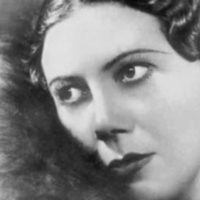 The information on the composer of Amuri amuri is scarse. Some sources state that Geni Sadero was born in Trieste in 1886 while others state that she was born in Constantinople and that her real name was Eugenia Scarpa. They agree however on the fact that she died in Milan in 1961. According to Baker’s Biographical Dictionary of Musicians (fifth edition), Sadero “specialized in collecting and singing regional folksongs of Italy; made a debut in opera at Milan (1914), but did not pursue a dramatic career. In 1919 she went to Paris, where she gave lecture-recitals on Italian popular music; in 1936 she returned to Italy and devoted herself to teaching; joined the staff of the Academy of Santa Cecilia in Rome. She published two collections of Italian songs (in Milan and New York). Also original songs with piano accompaniment.”
The information on the composer of Amuri amuri is scarse. Some sources state that Geni Sadero was born in Trieste in 1886 while others state that she was born in Constantinople and that her real name was Eugenia Scarpa. They agree however on the fact that she died in Milan in 1961. According to Baker’s Biographical Dictionary of Musicians (fifth edition), Sadero “specialized in collecting and singing regional folksongs of Italy; made a debut in opera at Milan (1914), but did not pursue a dramatic career. In 1919 she went to Paris, where she gave lecture-recitals on Italian popular music; in 1936 she returned to Italy and devoted herself to teaching; joined the staff of the Academy of Santa Cecilia in Rome. She published two collections of Italian songs (in Milan and New York). Also original songs with piano accompaniment.”
The history of recorded Sadero songs is rather short. The first recordings were made by Toti dal Monte in 1938/39 (Amuri Amuri, La barcarola della Marangona, Fa la mamma bambino [Lebendige Vergangenheit]). Rosa Ponselle added another version of Amuri Amuri in 1954 (one of her Villa Pace recordings [Romophone]) – a recording which is seen as a reference recording by many Ponselle- (and Not-Ponselle-) fans. In the beginning of the 1960s (I believe) Tito Gobbi added another recording of Amuri Amuri [EMI], and in 1965 Victoria de los Angeles recorded the song Era la vo [EMI]. Sadero’s songs a rarely performed. Not without a smirk I have therefore discovered that the famous transvestite and opera fanatic Vera Galupe-Borszkh (from the hilarious La Gran Scena Opera Company video) sang Amuri Amuri on her “4th Annual Comeback Recitals” (May 2005) in order to “recall Renata Tebaldi”!
The only tenor who recorded a Sadero piece is Ferruccio Tagliavini (Amuri Amuri for Cetra in 1949, with orchestra [Tima Club CLAMA CD-44]). The recording presented here is not identical with his 1949 recording. It is a rare private live recording of unknown date with piano accompaniment. Amuri Amuri (dedicated to the memory of Enrico Caruso) is a slow moving song in 6/8 time, in which a Sicilian waggoner, smitten by love, jogs along his horse. Love has changed him so much, he sings, he can no longer think. Here comes the (traditional) text in Sicilian dialect.
Geni Sadero: Amuri amuri – Tenor: Ferruccio Tagliavini (r. live 195x?)
Amuri, amuri, chi m’ai fattu fari?
Love, love, what have you made me do?
Li sensi mi l’ai missi in fantasia.
You have puzzled my senses.
Lu PatriNostru m’ai fattu scurdari
You have made me forget my fatherland
e la mita di l’Avvimmaria.
and made me sin against God.
Tenor Daniele Barioni (*1930)
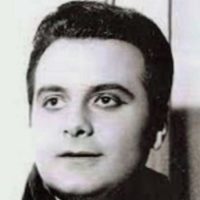 Daniele Barioni, indeed one of the – if not “the most beautiful tenor voice of our days”, as Mario del Monaco stated in 1959, had a characteristic career for a singer who seems to sing more with the heart than with the head. Sure, singing can get boring when the head is too much involved, but it is exactly this aspect that can possibly decide over the lenght of a singer’s career. If the voice is, as Melchior once said, carefully administrated like “money on a bank”, which means: taking care of the voice, never stop working on the technique, singing economically and reasonable – in other words performing like Kraus and Pavarotti – a long career can be a probable consequence (provided the singer has capital…). Daniele Barioni possessed a fortune which he lavished in a handful of performances he gave during a period of ca. 15 years. But the preserved recordings document performances of a rare and great intensity – singing straight from the heart, exciting out-and-out, a singer who is taken up completely with his roles, a warm and virile voice with stunning acuti – ruthless against the own instrument. Barioni therefore sang few, but very intense performances. It’s not exaggerated to say that Pavarotti or Domingo most probably sang in two years as many performances as Barioni did in his whole career. But, as a famous Italian statesman once said: Rather one day like a lion than a hundred years like a sheep.
Daniele Barioni, indeed one of the – if not “the most beautiful tenor voice of our days”, as Mario del Monaco stated in 1959, had a characteristic career for a singer who seems to sing more with the heart than with the head. Sure, singing can get boring when the head is too much involved, but it is exactly this aspect that can possibly decide over the lenght of a singer’s career. If the voice is, as Melchior once said, carefully administrated like “money on a bank”, which means: taking care of the voice, never stop working on the technique, singing economically and reasonable – in other words performing like Kraus and Pavarotti – a long career can be a probable consequence (provided the singer has capital…). Daniele Barioni possessed a fortune which he lavished in a handful of performances he gave during a period of ca. 15 years. But the preserved recordings document performances of a rare and great intensity – singing straight from the heart, exciting out-and-out, a singer who is taken up completely with his roles, a warm and virile voice with stunning acuti – ruthless against the own instrument. Barioni therefore sang few, but very intense performances. It’s not exaggerated to say that Pavarotti or Domingo most probably sang in two years as many performances as Barioni did in his whole career. But, as a famous Italian statesman once said: Rather one day like a lion than a hundred years like a sheep.
The recording presented here is an exemplary interpretation of the Tosti song. The voice flows on the air, sounds light and heavy at the same time and possesses a beautiful chiaroscuro. His execution is completed by a very impassioned and musical phrasing that suits the song very well.
Composer Francesco Paolo Tosti
 The two rather unknown pieces are followed by a real popular song: L’alba separa dalla luce l’ombra, no. 2 of the cycle Quattro canzoni di Amaranta, published in 1907. This song has, at least in relation to other songs by Tosti, been abundantly recorded by tenors: Caruso, Schipa, Björling, Chamlee, Tucker, Craig, Bergonzi, Pavarotti – and even Bocelli conserved this song on record. This belies the fact that the song originally was written for a female voice, just as the whole cycle (Canzoni di Amaranta). The other three songs have not entirely been recorded by tenors which is a real pity since the beauty and originality of the music even surpass the show piece. But the tenors’ choice often seems to be related to the particular effect of the song. Songs without any high notes do unfortunately not seem to be as attractive, no matter how good the music is.
The two rather unknown pieces are followed by a real popular song: L’alba separa dalla luce l’ombra, no. 2 of the cycle Quattro canzoni di Amaranta, published in 1907. This song has, at least in relation to other songs by Tosti, been abundantly recorded by tenors: Caruso, Schipa, Björling, Chamlee, Tucker, Craig, Bergonzi, Pavarotti – and even Bocelli conserved this song on record. This belies the fact that the song originally was written for a female voice, just as the whole cycle (Canzoni di Amaranta). The other three songs have not entirely been recorded by tenors which is a real pity since the beauty and originality of the music even surpass the show piece. But the tenors’ choice often seems to be related to the particular effect of the song. Songs without any high notes do unfortunately not seem to be as attractive, no matter how good the music is.
However, I don’t wish to belittle the quality of L’alba separa, which is a wonderful song. The whole cycle is set to poems by Gabriele d’Annunzio, an author who certainly vouches for high quality. The poem of the song presented here is a typical d’Annunzio poem: it’s the crack of dawn (a typical motive, a magical moment, a change of times) and the lyrical I calls for the night to stay. The night is connected to dreams, the daylight to the unwanted reality. The lyrical I asserts that death and heaven are preferable to the end of the dream. The dream as something that should replace reality – the dream as the new reality in contrast to reality which is perceived as nightmare.
The singing line of this song is (also unlike the other three songs of the cycle) very operatic, the song sounds almost like a Puccini aria, romantic and written in wide and big lines. The tessitura is high and requires a singer who possesses a voice of heroic colours, stamina and brilliant high notes – in other words: a spinto or heldentenor. This is exactly the reason why many a tenor did not manage to evoke the desired effect: Schipa, Bergonzi and Pavarotti made an undistinctive impression, while Tucker and Craig delivered awe-inspiring performances. L’alba separa is also one of the favourite pieces of Ben Heppner.
The recording presented here features Daniele Barioni in a live recording, made in 1961 by the Italian radio corporation (RAI). Here comes d’Annunzio’s text, again with English translation by Antonio Giuliano.
Francesco Paolo Tosti: L’alba separa dalla luce l’ombra – Tenor: Daniele Barioni (r. live 1961)
L’alba sepàra dalla luce l’ombra,
The dawn divides the darkness from the light,
E la mia voluttà dal mio desire.
And my sensual pleasure from my desire,
O dolce stelle, è l’ora di morire.
O sweet stars, the hour of death is now at hand:
Un più divino amor dal ciel vi sgombra.
A love more holy sweeps you from the skies.
Pupille ardenti, O voi senza ritorno
Gleaming eyes, O you who’ll ne’er return,
Stelle tristi, spegnetevi incorrotte!
sad stars, snuff out your uncorrupted light!
Morir debbo. Veder non voglio il giorno,
I must die, I do not want to see the day,
Per amor del mio sogno e della notte.
For love of my own dream and of the night.
Chiudimi, O Notte, nel tuo sen materno,
Envelop me, O Night in your maternal breast,
Mentre la terra pallida s’irrora.
While the pale earth bathes itself in dew;
Ma che dal sangue mio nasca l’aurora
But let the dawn rise from my blood
E dal sogno mio breve il sole eterno!
And from my brief dream the eternal sun!
Tenor Akifumi Maeda
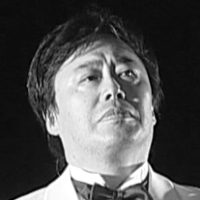 The present recording featuring Japanese tenor Akifumi Maeda is presented for the first time to a larger public, and listening to this complete interpretation of Respighi’s demanding song raises the question why this tenor has been ignored by recording companies that recently have re-discovered their interest for Italian art songs. His voice, that contains warm, mature, sandy elements, and that can remind to the voices of Giuseppe Campora and Gianni Raimondi, is by far superior to those of the tenors chosen by Bongiovanni & Co – not to mention the fine technique and the musical sensitiveness. A voice that is perfectly suited for Respighi’s songs, as well as for Mascagni’s demanding works.
The present recording featuring Japanese tenor Akifumi Maeda is presented for the first time to a larger public, and listening to this complete interpretation of Respighi’s demanding song raises the question why this tenor has been ignored by recording companies that recently have re-discovered their interest for Italian art songs. His voice, that contains warm, mature, sandy elements, and that can remind to the voices of Giuseppe Campora and Gianni Raimondi, is by far superior to those of the tenors chosen by Bongiovanni & Co – not to mention the fine technique and the musical sensitiveness. A voice that is perfectly suited for Respighi’s songs, as well as for Mascagni’s demanding works.
Maeda has been educated in Tokyo, Berlin and Vienna, inter alia by the German tenor Richard Gsell and American pianist Norman Shetler. In 1981 he won the first price at the 12th Concorso Lirico Italiano in Osaka. Maeda has performed in numerous engagements and concerts for example in Italy, Japan, Germany, Switzerland and Poland.
The present recording is a private recording, made during a recital in 1998. In this recital Maeda sang beside Sopra un’aria antica also other songs by Respighi: Nebbie, Pioggia and Nevicata, songs by Puccini and Neapolitan songs. Modern Italian art songs are inherent parts of Maeda’s repertoire as well as Japanese art songs or for example Benjamin Britten’s Michelangelo sonnets.
Today Maeda lives and works in Japan, and he ranks among the best Japanese tenors of our time.
Composer Ottorino Respighi
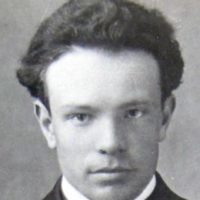 The last song of the selection is one of the most inspired and beautiful songs by Respighi. The “plot”, again a poem by d’Annunzio, is of unusual power: A lyrical I, distracted with desperation, unearthes his dead love and speaks to her for one last time. The atmosphere of this poem is so ineffably dark, sad, full of tenderness, pain and desperation – and so is Respighi’s masterly scoring. The tile of the poem, Sopra un’aria antica (On an old song), is realised by the use of the melody from the old Italian aria Intorno all’idol mio, which is interwoven with Respighi’s new music throughout the whole piece. Respighi had a soft spot for old music and used to adapt it, for example in the famous Antiche danze ed arie, in his Ciacconna or the Vetrate di chiesa. But this song is undoubtedly a highlight in his production.
The last song of the selection is one of the most inspired and beautiful songs by Respighi. The “plot”, again a poem by d’Annunzio, is of unusual power: A lyrical I, distracted with desperation, unearthes his dead love and speaks to her for one last time. The atmosphere of this poem is so ineffably dark, sad, full of tenderness, pain and desperation – and so is Respighi’s masterly scoring. The tile of the poem, Sopra un’aria antica (On an old song), is realised by the use of the melody from the old Italian aria Intorno all’idol mio, which is interwoven with Respighi’s new music throughout the whole piece. Respighi had a soft spot for old music and used to adapt it, for example in the famous Antiche danze ed arie, in his Ciacconna or the Vetrate di chiesa. But this song is undoubtedly a highlight in his production.
Sopra un’aria antica has not been recorded commercially by any tenor of international fame. The two recordings with the soprano Miwako Matsumoto from 1979 [VICS-60050] and the mezzo soprano Faridah Subrata are the only recording I know [Marco Polo 223347]. I am therefore proud to present for the first time this excellent private recording of the still active Japanese tenor Akifumi Maeda, made in Berlin in 1998. Here comes d’Annunzio’s original poem, with an English translation by B. Miller.
Ottorino Respighi: Sopra un’aria antica – Tenor: Akifumi Maeda (r. live 1998)
Non sorgono (ascolta ascolta)
Are there not arising (listen, listen)
le nostre parole
our words
Da quell’aria antica?
From that old aria?
Io t’ho dissepolta.
I have unearthed you.
E alfine rivedi tu il sole,
And at last you see the sun again.
Tu mi parli, o amica!
You speak to me, O Friend!
Queste tu parlavi parole.
These are the words you spoke.
Non odi? Non odi?
Don’t you hear, Don’t you hear?
Ma chi le raccolse?
But who gathered therm?
Dagli alvei cavi del legno
From the riverbeds carved from wood
i tuoi modi sorgono,
your expressions arise,
Che il vento disciolse.
to be scattered by the wind.
Dicevi: “Io ti leggo nel cuore.
You said: “I read you in your heart.
Non mi ami.
You don’t love me.
Tu pensi che è l’ultima volta!”
You think this is the last time!”
La bocca riveggo un poco appassita.
I see again your mouth a little withered.
“Non m’ami. È l’ultima volta
“You don’t love me. It is the last time.
Ma prima che tu m’abbandoni
But, before you abbandon me,
Il voto s’adempia.
the vow will be fulfilled.
Oh! fa che sul cuore io ti manchi!
Oh, may you miss me in your heart!
Tu non mi perdoni se già su la tempia baciata
You will forgive me if on my kissed temple
I capelli son bianchi?”
the hairs are white?
Guardai que’ capelli, su quel collo pallido
Look at those hairs, on that pale neck,
I segni degli anni;
the signs of the years;
E ti dissi: “Ma taci! Io t’amo.”
and I said to you “Be quiet! I love you”
I tuoi begli occhi erano pregni di lacrime
Your eyes were full of tears
Sotto i miei baci.
under my kisses.
“M’inganni, m’inganni” rispondevi tu,
“You deceive me, you deceive me,”
Le mie mani baciando.
you answered, kissing my hands.
“Che importa? Io so che m’inganni;
“What does it matter? I know you deceive me;
Ma forse domani tu m’amerai morta.”
but maybe tomorrow you’ll love me if I’m dead.”
Profondo era il cielo del letto;
Deep was the canopy of the bed;
Ed il letto profondo come tomba, oscuro,
and the deep bed, like the tomb, dark.
Era senza velo il corpo;
The body was without a veil;
E nel letto profondo parea già impuro.
and in the deep bed it seemed already impure.
Vidi per l’aperto balcone un paese lontano
I saw through the open balcony a distand land
Solcato da un fiume volubile,
furrowed by a meandering stream,
Chiuso da un serto di rupi
enclosed by a wreath of rocks
Che accese ardeano d’un lume vermiglio,
that burned brightly with a red light,
Nel giorno estivo; Ed i venti recavano odori
in the summer day; and the winds brought scents
Degli orti remoti
from the distant gardens
Ove intorno andavano donne possenti
around which were walking powerful women
Cantando tra cupidi fiori.
singing amid the covetous flowers.
Lastly, I present a list of CDs featuring the discussed songs of the composers presented above, sung by tenors.
Rossini:
- Carlo Bergonzi, Italian songs – Sony 60785 [La Promessa, La danza + Mascagni, Bellini, Verdi, Tosti] (1998)
- Pavarotti & Levine in recital (Met) – Decca DVD 000320809 [La Promessa, La danza + Bellini, Mascagni, Tosti, Verdi, Respighi] (1988/2004)
- Luciano Pavarotti, The 1989 Barcelona recital [La Promessa, La danza + Bellini, Mascagni, Respighi, Tosti] (1989/1999)
- Il salotto Vol. 6, Bruce Ford – Opera rara 227 [La Partenza] (2004)
La Danza has been recorded by [in alphabetical order] Beltrán, Bergonzi, Björling, Bocelli, Bonisolli, Carreras, Caruso, Gigli, Kiepura, Pavarotti, Peerce, Schmidt, Tauber, Tucker, Urrey, Watson.
As far as I could find out no recording of L’orgia by a tenor.
The mentioned recordings by Taro Ichihara were private off-the-air-recordings of a NHK broadcast.
Bellini:
- Pavarotti & Levine in recital (Met) – Decca DVD 000320809 [Sei ariette + Mascagni, Tosti, Verdi, Respighi] (1988/2004)
- Luciano Pavarotti, The 1989 Barcelona recital [Sei ariette + Rossini, Mascagni, Respighi, Tosti] (1989/1999)
- Luciano Pavarotti, The 40th anniversary recital – Decca 466350 [Sei ariette, Dolente immagine + Tosti]
- Canciones Espanolas e Italianas, Ruben Amoretti – Gall 731 [Malinconia, Ma rendi pur contento, Per pietà bell’idol mio, Dolente immagine + Respighi, Verdi] (1995)
- José Carreras, Italian opera composer’s songs – Sony 45863 [La ricordanza, Malinconia, Vaga luna, Per pietà, Il fervido desiderio, Dolente immagine + Verdi, Rossini, Donizetti]
- Jaime Aragall live – Columna 84 [Malinconia + Tosti, Puccini] (2004)
- Carlo Bergonzi, Italian songs – Sony 60785 [Vaga luna, Malinconia + Rossini, Mascagni, Verdi, Tosti] (1998)
Verdi:
- Complete chamber songs; Larin, Pertusi, Devia – Stradivarius 33545 (2000) [ca. 1/3rd of the songs is performed by Larin]
- José Carreras, Italian opera composer’s songs – Sony 45863 [In solitaria stanza, Il poveretto, Il tramonto, Brindisi, L’esule + Bellini, Rossini, Donizetti]
- Il salotto Vol. 5, Bruce Ford – Opera rara 223 [Cupo è il sepolcro e mutolo] (2003)
- Canciones Espanolas e Italianas, Ruben Amoretti – Gall 731 [In solitaria stanza, Stornello, L’esule + Bellini, Respighi] (1995)
- Alfredo Kraus in Recital – Capriccio Records 10272 [Ad una stella, Il tramonto, Lo spazzacamino + Mascagni, Respighi]
- Vola, o serenata, Otto Linsi – Gall 886 [Stornello, Brindisi, Non t’accostare all’urna + Puccini, Tosti, Donizetti] (1996)
Puccini:
- Vola, o serenata, Otto Linsi – Gall 886 [Terra e mare, Storiella d’amore, Avanti Urania!, Sole e amore + Tosti, Verdi, Donizetti] (1996)
- Beniamino Gigli, recital – Opera CD 54515 [Inno a Roma] (1937)
- La Rondine w/ Alagna and Gheorghiu – EMI 56338 [Morire?] (1997)
- The essential Placido Domingo – Sony 92845 [Sole e amore] (2004)
- Jaime Aragall live – Columna 84 [Terra e mare + Tosti, Bellini] (2004)
Tosti:
No recording of Quattro canzoni di Amaranta by a tenor; No recording of Malinconia by a tenor.
- Ben Heppner: Ideale – Deutsche Grammophon 185002 [This tasteful compilation contains three songs taken from Quattro canzoni and Malinconia: Lascia ch’io respiri, Invan preghi and L’alba separa.]
Recordings of L’alba separa have been made by the following tenors: Barioni, Bergonzi, Björling, Bocelli, Carreras, Caruso, Craig, Heppner, Lanza, Pavarotti, Schipa, Tucker.
Tenor Dante Ranieri has recorded a CD with songs by Tosti, but the CD is not available on the European and American market.
Respighi
- Complete songs*), Vol 1 & 2 w/ L. de Lisi (t), A. Catzel (s) – Channel Classics 9396 (1998)
- Alfredo Kraus in Recital – Capriccio Records 10272
[Notte, Stornellatrice, Ma come potrei, Nebbie, Tanto bella + Mascagni] - Liriche da camera – Axel Everaert – Pavane 7375 (1997)
[Deità silvane, L’ultima ebrezza, Pioggia, Lagrime, Tanto bella, Notte, Razzolan, L’udir talvolta, Ballata, Ma come potrei, Bella porta di rubini, Luce, Soupir, Contrasto, Invito alla danza, Storia breve, Scherzo, Notturno] - Lebendige Vergangenheit – Miguel Fleta III – Preiser 89149 [Nebbie] (1929)
- Canciones Espanolas e Italianas, Ruben Amoretti – Gall 731 [Nevicata, Nebbie + Bellini, Verdi] (1995)
- Pavarotti & Levine in recital (Met) – Decca DVD 000320809 [Nevicata, Pioggia, Nebbie – almost identical w/ the Barcelona program] (1988/2004)
- Luciano Pavarotti, The 1989 Barcelona recital [Sei ariette + Rossini, Mascagni, Respighi, Tosti] (1989/1999)*) The songs have not been entirely recorded
Sadero:
- Ferruccio Tagliavini – Tima Club CLAMA CD-44 [Amuri amuri] (1949)
Leoncavallo:
- Il mito dell’opera, Alessandro Bonci – Bongiovanni 1062 [Vieni amor mio] (1907/95) [note: The same is available on Preiser 89525]
- Great singers – Caruso Vol. 8 – Naxos Historical 8110726 [Lasciati amar + Tosti] (1913)
- Great singers – Caruso Vol. 9 – Naxos Historical 8110750 [Sérénades + Tosti] (1915)
Mattinata: Björling, Caruso, Cecil, Gläser, Di Stefano, Franchi, Fusati, Gigli, Lanza, Lenghi-Cellini, Lugo, Martinelli, Milona, Peerce, Piccaluga, Piccaver, Poncet, Schmidt, Smirnoff, Stampanoni, Vanzo, Valero, Vezzani, Wunderlich – Carreras, Domingo, Pavarotti, Leech. [note: Not all of the recordings mentioned here are available on CD.
Mascagni:
- Melodies and songs, Fausto Tenzi – Arts Music 47636 [Pena d’amore, La ballata di Maggio, Rosa, Stornelli marini, Sintomi d’amori, Serenata, Ave Maria, M’ama – non m’ama, La tua stella, Messaggio d’amore, Risveglio, La luna, Ballata, Spes ultima, Allora ed ora, Ascoltiamo, A Lilia, Bimba bionda, Intermezzo from Cavalleria] (2003)
- Mascagni songs, Angel Rodriguez – Bongiovanni 2235 [La tua stella, Pena d’amore, Messaggio d’amore, Sintomi d’amore, Allora ed ora, Ballata, Serenata, Spes ultima, ascoltiamo, L’addio di Palamidine] (1999)
- The Harold Wayne Collection Vol. 3, Francesco Marconi – Symposium 1073 [Bella cantiam l’amore] (1903/94)
- The Intermezzo from Cavalleria has been recorded by the following tenors: Schipa, Pavarotti, MacCormack, La Scola, Domingo and Carreras.
- Beniamino Gigli, O sole mio – EMI 63390 [Stornelli marini]
The Serenata has been recorded by the following tenors: Albanese, Bergonzi, Di Stefano, Martinelli, Pavarotti, Rodriguez, Tenzi, Valente and the mystery voice.
Giordano/Zandonai/Cilea/Alfano
- Il mito dell’opera – Antonio Paoli – Bongiovanni 1117 [Canzone guerresca by Giordano]
- Beniamino Gigli – Testament 1162 [Serenata malinconica by Giordano]
- The Caruso edition Vol. 4 – Pearl 4 [Chanson de juin by Giordano + Tosti]
- Italian songs by opera composers, Antonio de Palma – Bongiovanni – GB23692 [Giordano, Cilea, Alfano, Puccini, Zandonai – not all the songs are sung by de Palma, half of the program is done by soprano Ida Fratta]
